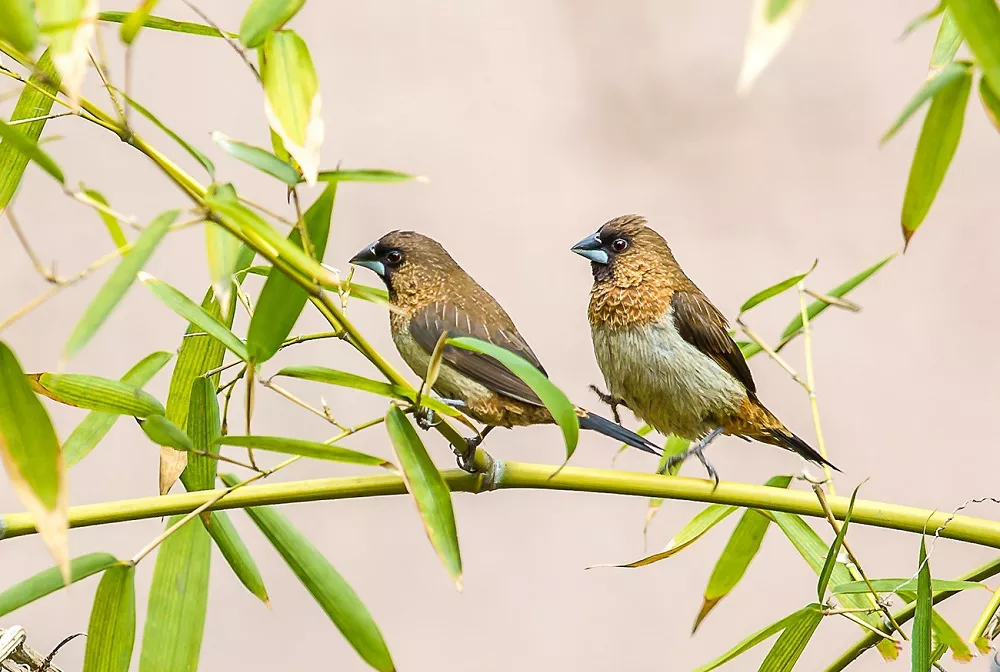The white-rumped munia (Lonchura striata) or white-rumped mannikin, is a small passerine bird from the family of waxbill “finches” (Estrildidae). Length: 10-13 cm, Weight: 9-15 g.
What does White-rumped munia look like
The white-rumped munia has similar plumage in both sexes. The forehead, the front of the top of the head, the front of the eyes, the circumference of the eyes, the cheeks and the base of the mouth are all dark brown, the back of the head to the back and shoulders are dark brown or taupe, with white or yellowish white feathers. The waist is white, and the overlying feathers on the tail are chestnut brown with brown-white feather stems and reddish-brown feather tips. Tail black, apex pointed, wedge-shaped. The two wings are dark brown, and the overlying feathers and tertiary flight feathers on the wings are the same as the back, but darker than the back, and also have brown and white feathers. Ear coverts and sides of neck light brown or reddish brown with thin white stripes or spots. The chin and throat are dark brown, the upper chest is chestnut, each feather has light yellow feather stems and light brown feather margins, the lower chest, abdomen and two flanks are white or off-white, and each feather has inconspicuous light brown “U”-shaped spots or scales Spots; perianal, undertail coverts and leg coverts chestnut brown with brownish-white fine lines or spots.
The juveniles are light brown or taupe above, each feather has white or brown-white feathers, the waist is off-white, and the overlying feathers on the tail are light yellow-brown with brown arc-shaped stripes and nearly white feathers. Chin, throat light grayish brown or gray, with light brown arc-shaped stripes, chest, undertail coverts and leg coverts light yellow-brown, each feather with light brown and gray-brown alternate arc-shaped stripes, belly, two flanks grayish-brown with yellow , the rest are like birds.
Iris reddish brown or light reddish brown, upper mouth black, lower mouth blue-gray, tarsus blue-brown or dark gray.
White-rumped munia habitat
It inhabits low mountains, hills and plains at the foot of mountains below 1500 meters above sea level, especially near streams, reed ponds, farmland and villages. It is common in forest margins, secondary shrubs, farmland and gardens at low altitudes. It can be as high as 1600 meters above sea level. Rarely go to middle and high mountain areas and dense forests.
White-rumped munia living habit
- Migration
White-rumped munia is a resident bird.
- Behavior
It is good at flocking. Except for activities in pairs during the breeding period, it often forms groups in other seasons, often with several or more than 10 individuals together. In autumn and winter, large groups of dozens or even hundreds of individuals are also seen. The combination of groups is relatively tight. , whether flying or resting, often huddled together. It often lives in bushes, bushes, bamboo bushes and grass, and also often moves in courtyards, fields and on the ground. It lives in groups on trees or bamboos at night. In summer and autumn, they often stand with sparrows on the ears of rice and ears of wheat to peck the seeds, and sometimes fly to grain warehouses in groups to steal food. Live in groups in old nests in winter, generally 10 or more live in an old nest together. It often stands on tree branches, bamboo branches and other high places to sing, and often sings while flying. The song is monotonous and weak, but very clear. When flying, the two wings flap very fast, and the sound of flapping wings can often be heard, especially when flying in groups, the sound is louder, fast and powerful, and advances in a wave shape. Gentle and docile, not afraid of people, easy to domesticate. A domesticated bird is very attached to people and the cage it lives in. It often opens the cage door and does not fly, or stands on people’s hands, and it can also be taught to do some simple actions.
- Food
Wild White-rumped munia mainly feeds on plant seeds, mainly rice, grains, grass seeds, seeds, fruits, leaves, buds and other plant foods, and also eats a small amount of animal foods such as insects.
Distribution area of White-rumped munia
Mainly distributed in Nepal, India, Sri Lanka, Bangladesh, Myanmar, Thailand, China, Malaysia and Indonesia.


 Facebook
Facebook  Instagram
Instagram  Youtube
Youtube 